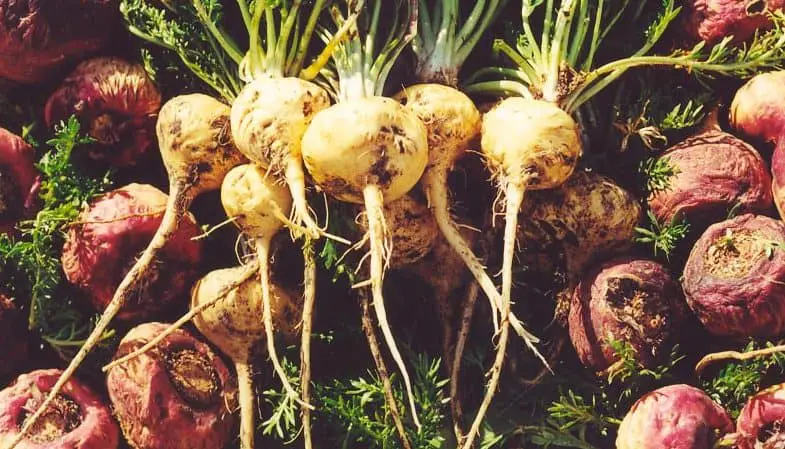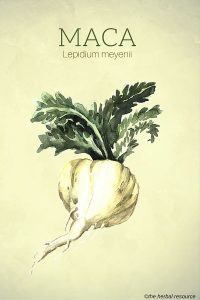Botanical Name: Lepidium meyenii.
Other Common Names Peruvian ginseng, maka, mace, maca-maca, maino, ayak chichira, ayuk willku, pepperweed.
Habitat Maca is found wild in Peru, Bolivia, Paraguay, and Argentina. It is primarily cultivated in the central highlands of Peru in the puna agro-ecological zone from 8,000 to 14,500 feet.
It is a valuable commodity to the Andean Indians and indigenous peoples in a region where poor and rocky soil, low temperatures, and high winds prohibit the cultivation of other crops. Cultivars of maca have been found in archaeological sites dating back to 1600 B.C.
Plant Description Lepidium meyenii is sometimes called Peruvian ginseng, although it is not in the same family as ginseng but is a member of the mustard family.
It is low-growing (12 to 20 cm) with a mat-like growth habit, and with scalloped leaves which renew from the center of the rosette.
The small, off-white flowers are typical of the mustard family and are self-fertilising. It is a perennial herb that propagates by seed; however, when cultivated for harvest it’s treated as an annual. Its root system requires seven to nine months to become mature enough to harvest.
The maca root looks like a large radish, has a tangy, sweet taste, and an aroma similar to that of butterscotch.
The four main cultivars of maca are black, purple, red and cream; no one of these has been definitely proven to be a superior medicinal herb to any of the others.
Plant Parts Used: The tuberose root of Lepidium meyenii is used both as food and as an herbal remedy. When the root of the maca plant is harvested, the roots are dried by exposing them to sunlight for 4-6 days.
The dried root can be stored in a cool, dry place for several years, and is easily rehydrated by boiling in water until soft.

Therapeutic Uses, Benefits and Claims of Maca Root
Maca root contains glucosinolates, the strong-smelling compounds that are responsible for the pungent smell and taste of mustard family plants, and isothiocyanates, which have been shown to block the formation of endogenous or exogenous carcinogens and so inhibit carcinogenesis.
Maca does not contain hormones; instead, it provides nutrients that nourish the endocrine system and enable the glands to produce essential hormones in specific amounts that are regulated as needed by the individual.
Lepidium meyenii is traditionally considered to be anti-fatigue, aphrodisiac, nutritive, immunostimulant, steroidal and tonic.
The nutritional value of maca root is high because it contains amino acids, complex carbohydrates, starch, glycosides, alkaloids, tannins, and vitamins B1, B12, C, and E. Maca varies between 12 percent and 14 percent protein, depending on the variety, and the fertility of the soil where it is grown.
Maca is 78 percent carbohydrate and is high in calcium and iron (15.4 mg per 100 g). Maca root has been an important food source for the indigenous peoples of the Andes because so little else will grow in the region. It is eaten baked, dried, mixed with milk, or in juices, porridges and jams.
The natives of the Andes traditionally have used Lepidium meyenii as a natural immunostimulant and to relieve stress.
Research supports the effectiveness of maca as one of the best medicinal herbs to be used to regulate and support endocrine health and it has been used as a remedy for hypothyroidism.
Other studies support that it is an effective herbal remedy for relief of stress.
Maca is thought to regulate the metabolism and is growing in popularity as a natural way to help the body produce stable energy instead of the temporary energy lift associated with strong stimulants.
Athletes find maca root useful as a natural way to enhance energy, stamina, and endurance. It is also used to promote mental clarity which could make it helpful for Alzheimer’s disease (AD).
The native people of the Andes used maca as a remedy for anemia, tuberculosis, stomach cancer, sterility, and other reproductive and sexual disorders.
Lepidium meyenii is used for the relief of chronic fatigue syndrome, menstrual disorders, and menopause symptoms.
It may relieve menopause symptoms because of its natural ability to help the body balance hormonal levels.
The native Peruvians have traditionally used the herb as an herbal remedy for impotence, to enhance fertility, and as an aphrodisiac. Preliminary studies have shown that maca may enhance libido, increase semen volume, increase sperm counts, and enhance sperm motility.
A number of animal studies indicate that maca root may increase sex drive and improve fertility. The red cultivar (but not the black or cream) also reduced enlarged prostates in rats.
Dosage and Administration
The amount used successfully in studies so far has been 500 to 1,000 mg three times per day of dried root powder in capsules.
It is often used in combination with catuaba, marapuama, and yohimbe bark as a natural remedy to enhance male libido.
Side Effects and Possible Interactions of Maca Root
Maca root contains more than 50µg of iodine, which worsens the side effects of thyroid disease.
It is also high in glucosinolates, which can cause goiter (swollen thyroid gland with decreased activity) if taken in excess combined with a low-iodine diet.
As it has been used as an herbal remedy for hypothyroidism it is very important that people with thyroid diseases consult their health care provider before consuming the root in any form. Some people are allergic to Lepidium meyenii, which can result in hives and fatigue.
Supporting References
Balick, M.J and Lee R: Maca: from traditional food crop to energy and libido stimulant. Altern Ther Health Med. 2002 Mar-Apr;8(2):96-8.
National Research Council: Lost crops of the Incas: little-known plants of the Andes with promise for worldwide cultivation. Washington, D.C. National Academy Press 1989.
Gonzales, G.F. and Cordova A, Vega K, et al. Effect of Lepidium meyenii (maca) on sexual desire and its absent relationship with serum testosterone levels in adult healthy men. Andrologia 2002;34:367–72.
Smith, E.: Maca root: Modern rediscovery of an ancient Andean fertility food. J Amer Herbalists Guild 2003;4:15–21.
Kilham, Christopher: Tales from the Medicine Trail: Tracking Down the Health Secrets of Shamans, Herbalists, Mystics, Yogis, and Other Healers. Emmaus PA. Rodale Press 2000.
Taylor, Leslie: The Healing Power of Rainforest Herbs. New York. Square One Publishers 2005.
Thordur Sturluson
Latest posts by Thordur Sturluson (see all)
- What is the Difference Between Hemp and Marijuana? - June 3, 2019

Leave a Reply